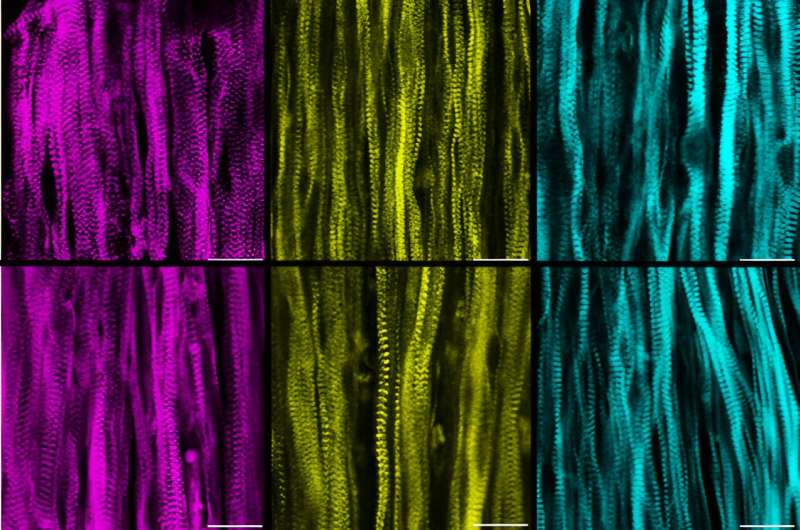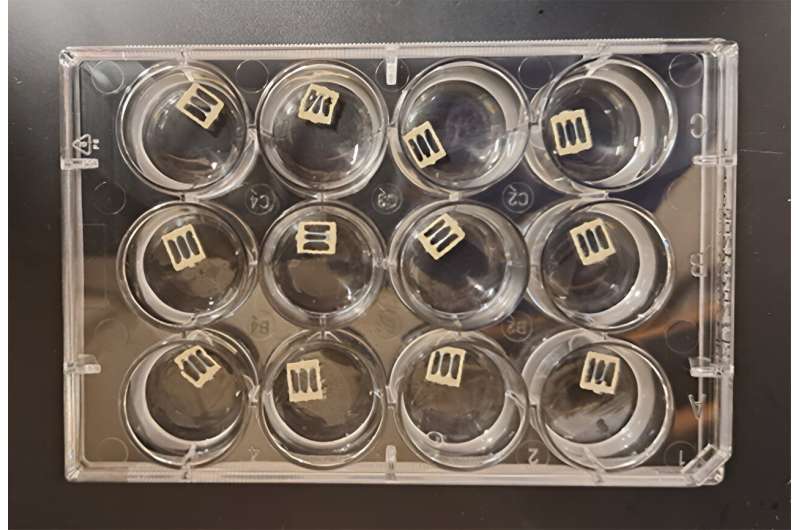This article has been reviewed according to Science X's editorial process and policies. Editors have highlighted the following attributes while ensuring the content's credibility:
fact-checked
peer-reviewed publication
trusted source
proofread
Lab-grown muscles reveal mysteries of rare muscle diseases

Biomedical engineers at Duke University have developed a new technique to better understand and test treatments for a group of extremely rare muscle disorders called dysferlinopathy or limb girdle muscular dystrophies 2B (LGMD2B). The approach grows complex, functional 3D muscle tissue from stem cells in the laboratory, creating a platform that replicates patient symptoms and treatment responses.
In their debut study, researchers reveal some of the biological mechanisms underlying the characteristic loss of mobility caused by LGMD2B. They also demonstrate that a combination of existing treatments may be able to alleviate some of the worst symptoms of the disease.
The results appear in the journal Advanced Science.
LGMD2B affects only about eight people per million around the world. Unlike it's more well-known and more common cousin Duchenne muscular dystrophy, the disease affects both men and women, presents later in life—in the late teens or early 20s—and is rarely fatal. However, LGMD2B patients develop severe weakness in the legs and shoulders, typically requiring them to use wheelchairs for the rest of their lives.
Caused by a genetic disorder, LGMD2B stops the body from creating a fully functional form of a protein called dysferlin. There are currently no approved treatments or cures. Part of the reason for this lack of options is the many functions of dysferlin, including sealing holes in muscle membranes, regulating calcium balances required for muscle contraction and controlling cellular metabolism. And for reasons unknown, affected muscles initially accumulate fat within the muscle fibers themselves before degenerating and ultimately being replaced by fat cells.
"This phenomenon is very rare even for muscular dystrophies," said Nenad Bursac, professor of biomedical engineering at Duke. "It's a burning question within the community of why that happens."
One of the challenges facing researchers trying to solve these problems is that the mouse model used to approximate LGMD2B shows very mild symptoms compared to patients. Mice with the disease are still able to walk, and it does not present until nearly a year into their two-year long lifespan, making studies of the disease extremely slow.
Dysferlin is expressed in other cell types, and blood levels of metabolic fuels such as cholesterol are also altered in mice and patients. Together, this complicates LGMD2B research by making it difficult to assess what cell types are responsible for the disease and if metabolic changes are due to the loss of dysferlin itself or whole-body effects.
To get around these challenges, Bursac and his research scientist Alastair Khodabukus turned to an engineered muscle platform that they have been developing for nearly a decade. The Bursac Lab was the first to grow contracting, functional human skeletal muscle in a Petri dish and has been improving its processes ever since to enable studies of muscle strength, metabolism and repair. This system allowed them to focus their study on only the effects of dysferlin on skeletal muscle without the complications of other cell types or altered blood metabolite profiles.
In the study, the researchers began with induced pluripotent stem cells (IPSCs) derived from patients living with LGMD supplied by The Jain Foundation, a charity focused on finding a cure for LGMD2B. Using their muscle-growing techniques, the lab matured these stem cells into muscle fibers and ran them through a battery of tests over the course of six weeks.

Like muscles found in patients themselves, the lab-grown versions displayed a wide variety of issues.
"Overall, our model repeated a lot of the clinical manifestations of the disease and observations made in real patients, but it was all done in a Petri dish," said Bursac. "We've been able to gain new insights into the muscle-specific aspects of the disease."
The researchers discovered that the loss in muscle strength was not the result of deficiencies in muscle structure or size, but in its handling of calcium. Muscle contractions are physically caused by reservoirs of calcium in muscle cells being released and binding to muscle proteins. Tests showed that the diseased muscle cells had sprung leaks in their calcium reserves, resulting in less calcium to release and weaker contractions.
The researchers also showed that the lack of dysferlin caused damage to the muscle cells to go unrepaired, and that an inability to burn fatty acids for energy production was at least partially to blame for the accumulation of fat within muscle fibers that has long puzzled the medical community.
"We replicated something seen in patients and showed that it's not due to environmental factors within the body, but issues within the muscle itself," Khodabukus said.
The researchers then tested the effects of two drug candidates to potentially treat the disease that have been identified through mouse models but have not yet been tested in humans. One called dantrolene is supposed to stop calcium from leaking from muscle cells' reservoirs. The second, called vamorolone, was recently approved for use with Duchenne muscular dystrophy patients, although researchers do not fully understand how it works.
Together, the drugs prevented the calcium leak and helped the cell membrane repair itself, restoring much of the muscles' strength. And while they also helped reduce the amount of fat accumulated within the muscles, they did not fully prevent it, nor did they help the muscles efficiently burn fats for fuel.
Moving forward, the group is planning to add immune and fat cells to their experiments for greater complexity. They also are looking to further understand disruptions to cellular metabolism and to find new drugs that fully restore all strength, repair and metabolic deficit.
"Right now, we have a basic muscle-only system, which is great to see the effects of the disease within the muscle itself, but what is also important is the crosstalk between immune cells, fat cells and muscle cells," Khodabukus said. "By building out our system more, we'll hopefully be able to fully figure out what is driving the loss of muscle and its replacement by fat in these patients."
More information: Alastair Khodabukus et al, Bioengineered Model of Human LGMD2B Skeletal Muscle Reveals Roles of Intracellular Calcium Overload in Contractile and Metabolic Dysfunction in Dysferlinopathy, Advanced Science (2024). DOI: 10.1002/advs.202400188



















